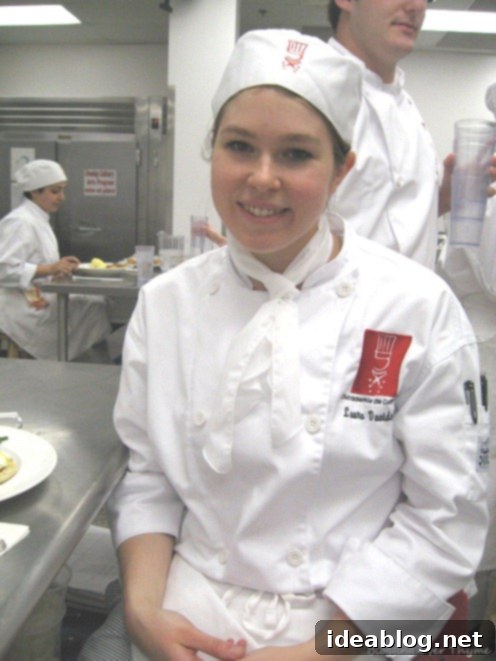Mastering Hollandaise and Eggs Benedict: A Culinary School Deep Dive into Classic Techniques
After dedicating two intensive days last week to sanitation protocols, followed by a much-needed four-day weekend of relaxation, a familiar sense of apprehension began to creep in. I worried that my newly acquired culinary rhythm might have been lost, especially as Tuesday morning approached. My usual — and admittedly quite bothersome — paranoia kicked in, causing me to wake almost hourly on Monday night, terrified I would oversleep my alarm. Thankfully, these fears were unfounded. I arrived early, contributed to the classroom setup, and settled into my seat in the lecture hall promptly at 7:00 am, ready for another challenging day.
My nervousness intensified considerably the moment my gaze landed on the whiteboard, revealing the day’s menu. It was official: today was **HOLLANDAISE** day. Our chef’s ominous but accurate description of it as “the sauce that smells fear” echoed in my mind, setting the stage for what I knew would be a pivotal learning experience. This emulsified classic is notorious for its temperamental nature, demanding precision and confidence from even seasoned cooks.
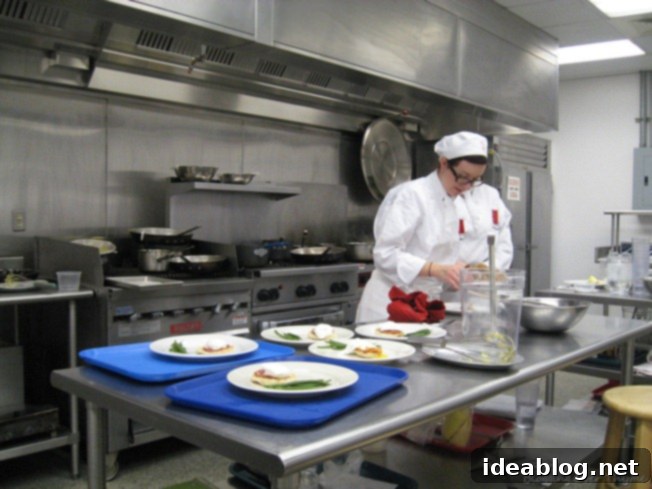
The Art of Hollandaise: A Mother Sauce Revealed
As per tradition, our meticulously prepared hollandaise sauce was destined to crown the quintessential breakfast dish: **Eggs Benedict**. While Eggs Benedict had never been my personal go-to, the prospect of finally mastering this iconic dish from scratch filled me with both excitement and a healthy dose of trepidation. Understanding the foundation of hollandaise is crucial for any aspiring chef.
Hollandaise holds a prestigious place as one of the **five classic mother sauces** in French cuisine, a group that forms the backbone of countless other sauces. The other four pillars are velouté, tomato, béchamel, and brown sauce or sauce espagnole, all of which we look forward to exploring in due course. Hollandaise itself is remarkably simple in its composition, requiring only five core ingredients: **clarified butter**, **egg yolks**, **cayenne pepper**, **lemon juice**, and **salt**. The choice of clarified butter — butter that has been gently heated to separate and remove milk solids and water — is deliberate. Its higher smoke point and lack of water content facilitate a more stable and robust emulsification, which is the heart of this delicate sauce.
Our lesson revealed that the actual process of making hollandaise isn’t inherently complex. The true challenge, however, lies in properly holding the sauce, maintaining its emulsified state, and preventing it from breaking (separating), curdling, or becoming otherwise compromised. While this might be less of an issue in a home kitchen where immediate consumption is typical, in a professional restaurant setting, components must be prepped and held in advance, making temperature control absolutely paramount. Chef emphasized the “four enemies of hollandaise”: “too hot,” “too cold,” “too thick,” or “too thin.” Any deviation from the ideal narrow temperature window and perfect consistency can lead to disaster.
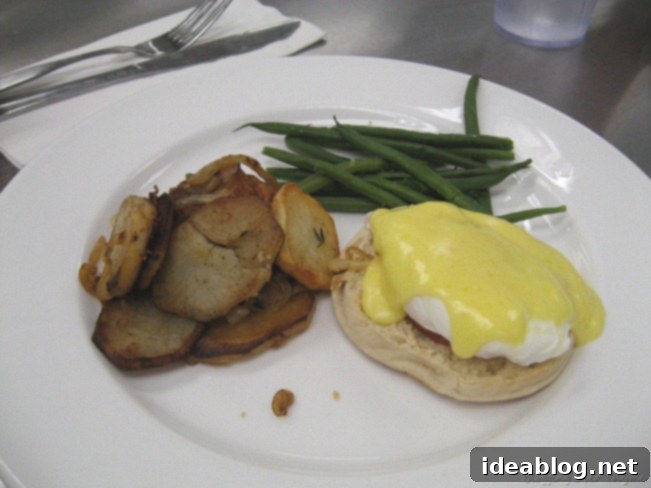
Crafting the Perfect Emulsion
The fundamental technique for hollandaise involves gently heating egg yolks with a minuscule amount of water over a bain-marie (a simmering double boiler). This gentle heat gradually cooks the yolks, causing them to gain volume and thicken to a consistency where the whisk leaves distinct trails in the sauce. Once this stage is reached, the eggs are removed from the direct heat of the double boiler, and the meticulous process of emulsification begins. While whisking the yolks constantly and vigorously, clarified butter is slowly streamed in, typically at a ratio of one egg yolk to two ounces of clarified butter. This gradual addition, coupled with continuous whisking, creates a stable suspension of fat droplets within the egg yolk mixture, resulting in the creamy, velvety texture characteristic of hollandaise sauce.
Once the emulsion is perfectly formed, the final flavor profile is achieved by incorporating **cayenne pepper, salt, and, most critically, lemon juice**. The trick, as our chefs repeatedly stressed, is to add just enough acidity from the lemon juice to expertly cut through the richness of the butter and egg yolks. This balance is vital; it prevents the sauce from feeling overwhelmingly heavy and ensures that each spoonful leaves a desire for more. You should be able to distinctly taste the bright tang of lemon, which provides a refreshing counterpoint to the sauce’s inherent fat content. This careful seasoning is what elevates hollandaise from merely a rich topping to an irresistible culinary delight.
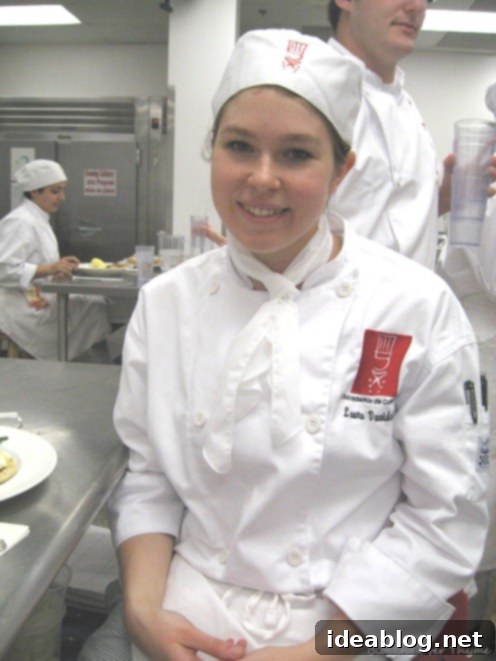
Despite my initial nervousness when I embarked on making my hollandaise, I found myself genuinely pleased with the outcome. My sauce remained perfectly emulsified, showing no signs of breaking, even though I had prepared it well in advance of service. While I noted that I could have been more generous with the lemon juice and seasoning, the overall texture and stability were excellent. A crucial troubleshooting tip we learned for salvaging a slightly broken hollandaise is to incorporate a small amount of *warm* water while whisking vigorously; this can often bring the emulsion back together.
Perfecting Poached Eggs: The Foundation of Eggs Benedict
Our perfectly crafted hollandaise was, of course, destined to be served Benedict style—draped generously over freshly poached eggs. This marked our first practical lesson in egg cookery, and it was particularly exciting for me, as my previous attempts at poaching eggs at home had met with limited success. I was eager to learn the professional techniques to perfect this delicate art.
The process began with filling a pot with four inches of water, which was then acidulated with distilled white vinegar. The vinegar serves a vital purpose: it helps to coagulate and tighten the proteins in the egg whites, minimizing their tendency to scatter when dropped into the water. We brought the water to a gentle heat, observing for the appearance of small, delicate bubbles along the bottom of the pan—a sign of the ideal simmering temperature, just below a rolling boil. To further prevent the whites from dispersing, we carefully cracked each egg into individual ramekins, then gently lowered them into the simmering water. The eggs should initially sink to the bottom, where the whites slowly begin to set and gather around the yolk, eventually causing them to rise gracefully to the surface as they cook. The goal is a firm white and a perfectly runny yolk.
A key insight gained for restaurant-level efficiency was the technique for **poaching eggs** ahead of time and **holding** them for reheating. Since rushing to poach dozens of eggs minutes before service is impractical, we learned to poach them until the whites were mostly cooked through, then immediately transfer them with a slotted spoon or sieve into a basket immersed in ice water. This halts the cooking process. Then, just prior to service, these pre-poached eggs are gently returned to hot water for a brief reheat. This method, which allows restaurants to prepare and serve massive quantities of Eggs Benedict efficiently, was truly fascinating and highlighted the strategic thinking required in a professional kitchen.
I am quickly realizing that the logistical challenge of holding and maintaining foods at the correct temperature for service, not to mention coordinating their reheating, often proves to be the trickiest aspect of planning a menu. It’s a delicate dance of timing and precision.
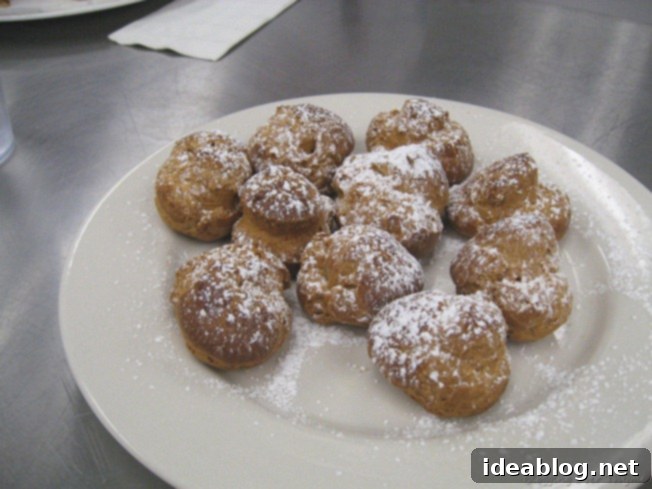
Complementing the Classics: Savory Sides and Sweet Treats
Our exquisite Eggs Benedict was served alongside a selection of classic French accompaniments: **LES POMMES DE TERRE SAUTEES LYONNAISE** and **LES HARICOT VERTS A L’ANGLAISE**. In simpler terms, these translated to savory sautéed potatoes with onions, and perfectly plain, cooked green beans.
The Lyonnaise potatoes were prepared with meticulous care. We started by slicing the potatoes into uniform 1/4-inch rounds, which were then thoroughly dried to ensure optimal browning. These potato slices were then cooked in clarified butter over high heat. The secret to achieving a desirable crispness and preventing them from sticking was to avoid crowding the pan, instead spreading them in a single layer across the entire surface. We carefully flipped them to ensure even browning on all sides. Once the potatoes had developed a beautiful golden crust, thinly sliced onions were added to the pan, cooking until they became lightly caramelized, adding a subtle sweetness and depth of flavor. A final sprinkle of fresh thyme elevated these humble potatoes into a dish reminiscent of a gourmet diner experience.
In addition to these savory dishes and the star attraction, Eggs Benedict, our busy day also included learning to create **PATE A CHOUX**. This versatile and light pastry dough is traditionally used for an array of delightful pastries, including éclairs, gougères, and, in our case, **CREAM PUFFS**, which are beautifully showcased in the image above. The technique itself is relatively straightforward, but it demands careful attention to detail during the piping process and precise timing during baking. Once the pâte à choux shells were baked—to the point where their interiors were very dry and almost hollow, indicating perfect doneness—they were cooled and then filled with a rich pastry cream, which we had fortunately practiced making just the previous week. My diligent practice over the weekend clearly paid off!
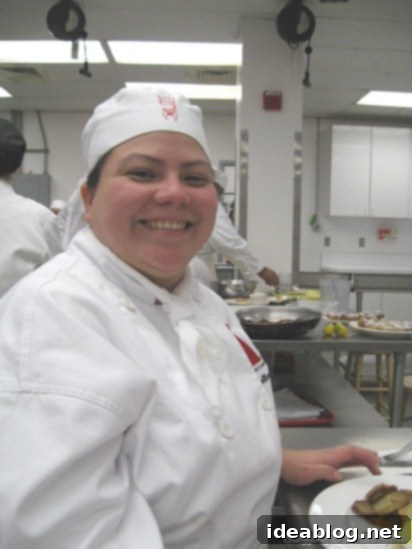
My fantastic work table partner for the day, Blanca! Learning alongside talented peers makes the culinary journey even more rewarding.
All of these freshly prepared dishes culminated in a delightful and thoroughly satisfying lunch, a testament to our morning’s intense efforts.
Beyond the Kitchen: Delving into Meat Butchery and Culinary Theory
The afternoon brought a shift from practical cooking to theoretical instruction with a quick lecture from our esteemed school director, Chef Francois. He provided us with an introductory overview of the complex and fascinating world of **MEAT**. Apparently, from this point forward, each Tuesday afternoon will be dedicated to comprehensive lectures focused on mastering the art of meat butchery. This prospect is incredibly exciting and promises to be highly informative, especially considering my current limited knowledge in this specialized area. Understanding different cuts, proper handling, and efficient butchery techniques is a fundamental skill for any professional chef.
As my day concludes, I am now transitioning to working on my first paper for school, which I’ll be presenting tomorrow. It feels surreal to think that I’ve just completed a four-page paper entirely dedicated to *saffron*! Is this truly the trajectory my life has taken? Each day in culinary school brings new revelations, from emulsifying delicate sauces to exploring exotic spices, broadening my culinary horizons in unexpected ways.
P.S. On a separate note, this blog post is a little more delayed than I initially intended because this afternoon, I found myself sitting outside my apartment for over an hour. There had been a small fire in my building! Fortunately, no one was hurt, and the fire department was able to extinguish it quickly. My apartment, being three floors above, was safe, but the lingering smell of smoke was still noticeable upon my return. What an utterly bizarre and eventful end to an already packed day!
